 Outside gold miners' huts, Mount Dromedary, 1890s
Outside gold miners' huts, Mount Dromedary, 1890s
TLF ID R3181
This is a photograph, taken by William Henry Corkhill (1846-1936) in the late 1890s, showing four gold miners standing outside a simple slab hut on the Mount Dromedary diggings in southern New South Wales. The hut stands on a narrow terrace cut into the hillside amid the bush. Firewood and housekeeping utensils lie on the ground outside. The men appear to have been engaged in peeling potatoes. They are casually dressed in shirtsleeves and three of them have their trousers tied around the knees with bowyangs. Another hut is visible in the foreground.
